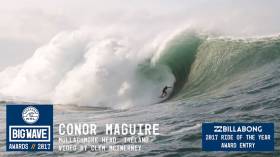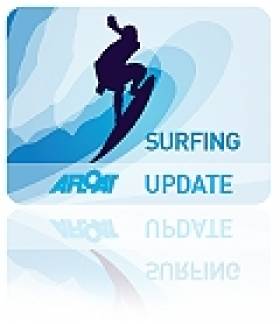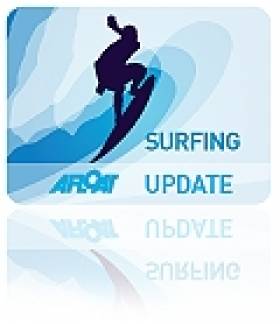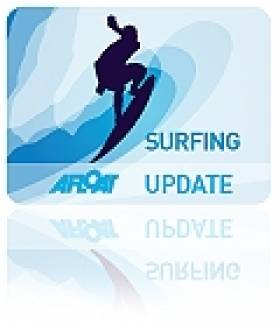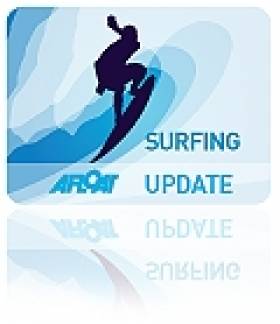Displaying items by tag: Peter Conroy
Two Irish Surfers Up For 2017 Big Wave Prize
#Surfing - Two Irish surfers are nominated for ride of the year in the 2017 WSL Big Wave Awards after taking on the monster swell at Mullaghmore Head last month.
Conor Maguire and Peter Conroy were in the right place at the right time on 9 February to get a tow-in to the ‘emerald walls’ at the surfing hotspot off Co Sligo.
Bundoran resident Maguire found himself barrelled by the kind of surf usually associated with the big wave paradises of the Pacific.
Meanwhile, Northcore team member Conroy, from Co Clare, caught his own massive wall of water to stake his claim among the world’s top riders.
Both clips were captured by Clem McInerney, who was also on hand to shoot one of American surfer Will Skudin’s two nominated efforts at Mullaghmore — as well as Dublin-based Emirati surfer Mo Hassa Rahma’s spectacular wipeout, as The National reports.
Peter Conroy Latest To Join Northcore Surfing Stable
#Surfing - Irish big wave rider Peter Conroy is the latest addition to the Northcore surfing team.
A relatively late starter in surfing at the age of 16, the Clare native had a solid background in competitive swimming and lifeguarding to build upon
That meant he was well prepared for the heavy surf off Ireland's West Coast, where he keeps a rigorous fitness and training regimen, including his chairmanship of the Irish Surf Rescue Club - organisers of the annual Tow-In Surf Session.
This summer he celebrated his nomination for the 'tube of the year' gong in the Billabong XXL Big Wave Awards.
And now he's a part of Northcore's surfing squad for the UK and Ireland, alongside fellow Irish riders Conor Maguire - who joined two years ago - and team ambassador Richie Fitzgerald.
Conroy said of joining the team: "I'm very excited to work with the Northcore crew for future projects and pushing my limits further with the help of their excellent products."
Northcore's spokesperson added: "We are really pleased to welcome Peter to our team. He's a well respected, talented surfer with a wealth of big wave surfing experience and skills.
"He charges the biggest, meanest waves out there amongst some of the worlds very best as his nomination for XXL Ride of the Year testifies! It's an honour to welcome Peter to Northcore."
Irish Surfer, Snapper Up For 'Tube Of The Year' Gong
#Surfing - Ireland is represented for another year running on the shortlist for the Billabong XXL Big Wave Awards to be presented next month.
According to The Irish Times, Clare surfing pro Peter Conroy and Portrush photographer Roo McCrudden are in the running for the 'tube of the year' gong, which could net them a cool $5,000 in prize money.
McCrudden captured the stunning shot of Conroy riding the tube formed by an enormous cresting wave Mullaghmore in Sligo - a break that proved similarly attention-worthy for last year's 'biggest wave' nominee Ollie O'Flaherty.
Conroy told the paper that the magic wave "came out of nowhere" and that he didn't even realise just how big it was till he saw McCrudden's photographs later.
The Irish Times has more on the story HERE.
Big Waves Come to Mullaghmore After Long Wait
#Surfing - Some of the world's top big wave surfing talent enjoyed the 'day that almost never was' at Mullaghmore in Sligo on Sunday.
As the video above shows, competitors in the long-delayed Billabong Tow-In Session finally got a chance to prove their mettle after two amber alerts in a week for the international event, pushed back from last year after a calm storm season.
Confidence was high as the storm front that has been battering Ireland for the past two days made its way across the Atlantic, bringing with it the giant swells needed to green-light the action.
Big wave surfers being secretive sorts, due to the dangerous nature of offshore tow-in surfing and their determination to keep their favourite spots 'just for them', we don't yet have results of the action, or even confirmation that the waves were big enough to count!
But what we do know is that the likes of Billabong XXL 2013 Ride of the Year nominee Peter Conroy were present and ready to tackle the colossal walls of water Mother Nature was set to provide.
Meanwhile, Met Eireann warns that gale force winds are expected to continue today (29 January) with southwesterly gusts of up to 110 km/h possible. Those in coastal areas have been warned to exercise caution.
The Wait Begins for Second Tow-In Surf Session
#SURFING - The waiting period for the second Tow-In Surf Session at Mullaghmore Head is now under way.
The invite-only list of the world's top big wave surfers has until 1 March 2012 to try to best the monster waves ridden in last February's inaugural contest.
Irish pioneers Richie Fitzgerald, Peter Conroy and Glyn Ovens will be on call for the return event, which has also invited back open teams winners Benjamin Sanchis and Éric Rebière, according to Surfworld Bundoran.
Sanchis is also the 2011 Billabong XXL biggest wave award winner, and intends to defend his crown in Sligo.
“Mullaghmore is a spectacular wave, but you really need to be prepared to surf big waves there," he said.
The first Tow-in Surf Session - which was even immortalised in a documentary - was organised by the Irish Surf Rescue Club in part to dispel the myth that tow-in surfing, where surfers are towed by jetski to bigger offshore waves, is an irresponsible activity.
“Our team has put an enormous amount of training, both here and abroad, to ensure that the sport of tow surfing and this event can be as safe as possible," said organiser Paul O'Kane.
The latest news on the second Tow-In Surf Session will be made available on the Billabong website HERE.
Surfers Take On Big Waves in Sligo
More than 20 of Ireland's and Europe's top surfers took on the monster waves at Sligo’s Mullaghmore Head at the weekend in Ireland's first ever 'big wave' surf contest.
The Tow-in Surf Session was organised by the Irish Surf Rescue Club in part to dispel the myth that tow-in surfing - where surfers are towed by jetski to bigger offshore waves - is an irresponsible activity.
Club president Paul O’Kane told The Irish Times: “Our surf riders and personal watercraft operators are all very safety conscious, highly trained, and contests like this can help to further develop skill sets.”
Eric Ribiere and Benjamin Sanchis from France took top place in the open category in a contest that rewarded skill and commitment on the biggest waves. Peter Conroy and Gyln Ovens came first in the Irish division, follwed closely by Al Mennie and Andrew Cotton.
Awards went to professional boarder Gabe Davies for best wave, Al Mennie for best barrel and Richie Fitzgerald for heaviest wipeout.
Easkey Britton also held her own as the only female competitor on the day, catching a solid 20-foot wave.
Click HERE for more video of the contest's big wave surfing action.



























